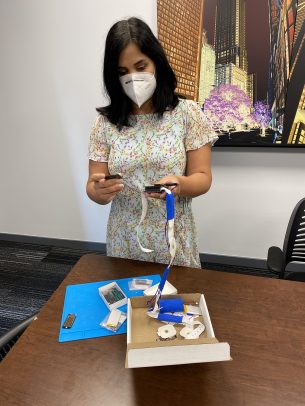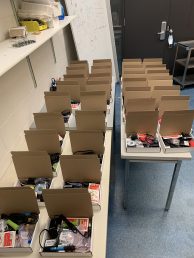Online learning allows students to discover ‘incredible implications of wearable technology’

When Hananeh Esmailbeigi first came up with the idea behind her course, Wearables and Nearables Technology Laboratory at the University of Illinois Chicago, she envisioned it as a way that her students could tap into the quickly growing wearable technology trend that had saturated the market with portable fitness trackers, smart homes and other devices.
Little did the clinical associate professor at UIC know that three years later, the COVID-19 pandemic would require our lives to be governed by similar devices that are, in real-time, tracking our exposure to others, checking our temperatures, and chronicling our heartbeats and respiration.
“They are quantifying pretty much every aspect of our lives these days,” Esmailbeigi said.
Esmailbeigi, who also is associate director of undergraduate studies in the bioengineering department, joined with Joe Hummel, clinical associate professor and director of undergraduate studies in computer science, both within the College of Engineering, to cross-reference the class.

The goal was for students to work in multidisciplinary teams to mimic a “real industry environment” that requires people to work with others from different disciplines, Esmailbeigi said.
Among the wearable technology they have developed are devices that track your gait when walking, a fitness band that checks breathing and heart rates and sensors that track blood oxygenation levels. They’ve also had a “smart tattoos” lab, where students design tattoos that can be worn on the skin and used to do everything from help play musical instruments or type, among other things, she said.
The 400-level course is capped at 32 students who tend to be seniors and graduate students. Normally, eight groups of four students are made up of a combination of bioengineering, mechanical engineering and computer science students who team up and collaborate in a campus lab to produce a single wearable technology device.
They work on coming up with ways to design portable electronics and consider different aspects, from design to hardware. They are taught to design and manufacture circuit boards as well as design the product. In addition, they take bioengineering aspects to mind, such as how the device will safely interact with the body and how to make it as compact and streamlined as possible without dangling wires or exposed circuits. And then the user-interface is considered to make the data as clear and attractive as possible.

“They’re involved in packaging the devices, designing them, thinking about the user’s needs and thinking about how to visualize the data so it is user friendly so everyone can understand it,” she said.
But this fall as classes go remote, students will be responsible for their own device, from start to finish. To prepare for the fall class, Esmailbeigi and her two teaching assistants, Nicholas Marjanovic and Joshua Smejkal, spent the summer preparing kits with enough components to build the devices.
Esmailbeigi and the teaching assistants put together enough materials to make 32 kits containing enough wiring, circuit boards and other components to make 32 devices, as well as surplus parts.
The students will be sent the kits and broken into groups of four. Once the deliveries are made, the groups will be meeting together on Blackboard, where they will be tasked with helping each other out.
“Everyone is at home, or where they are working, building these devices and will be talking over Blackboard together and helping each other with things like wiring, making sure they are correctly connected and writing the code together,” she said.
The silver lining of going virtual is that each student will have the ability to learn how to put together the devices from start to finish, whereas in the past, some students shied away from different aspects of the work. Also, previously students had to work on the projects in a lab setting during class.
“Now, they can work on them outside of the class at any time, so the school doesn’t even have to be open; they can work on the devices when they want,” she said. “Personally, in general, I am an extrovert and I get a lot of energy from the interactions with the younger generations. I think we did our best to have this course be as productive as possible.”
Manuela Burek, a senior studying bioengineering, is taking Esmailbeigi’s class this semester. She said she has been looking forward to taking the class because she is interested in learning about the “incredible implications of wearable technology in health care.”
She is proud of the work Esmailbeigi has done to plan the course and to make sure nothing is lost as the class transitions to online learning. She said providing each student with an individual kit has prepared them for the online class.
“I think this class will be a unique opportunity to collaborate with students from other departments while still fully experiencing each part of the device development individually,” Burek said. “Being especially interested in medical device development, I’m most excited about getting to actually build and test these technologies for myself, something that I didn’t think I would get the opportunity to still do remotely.”
